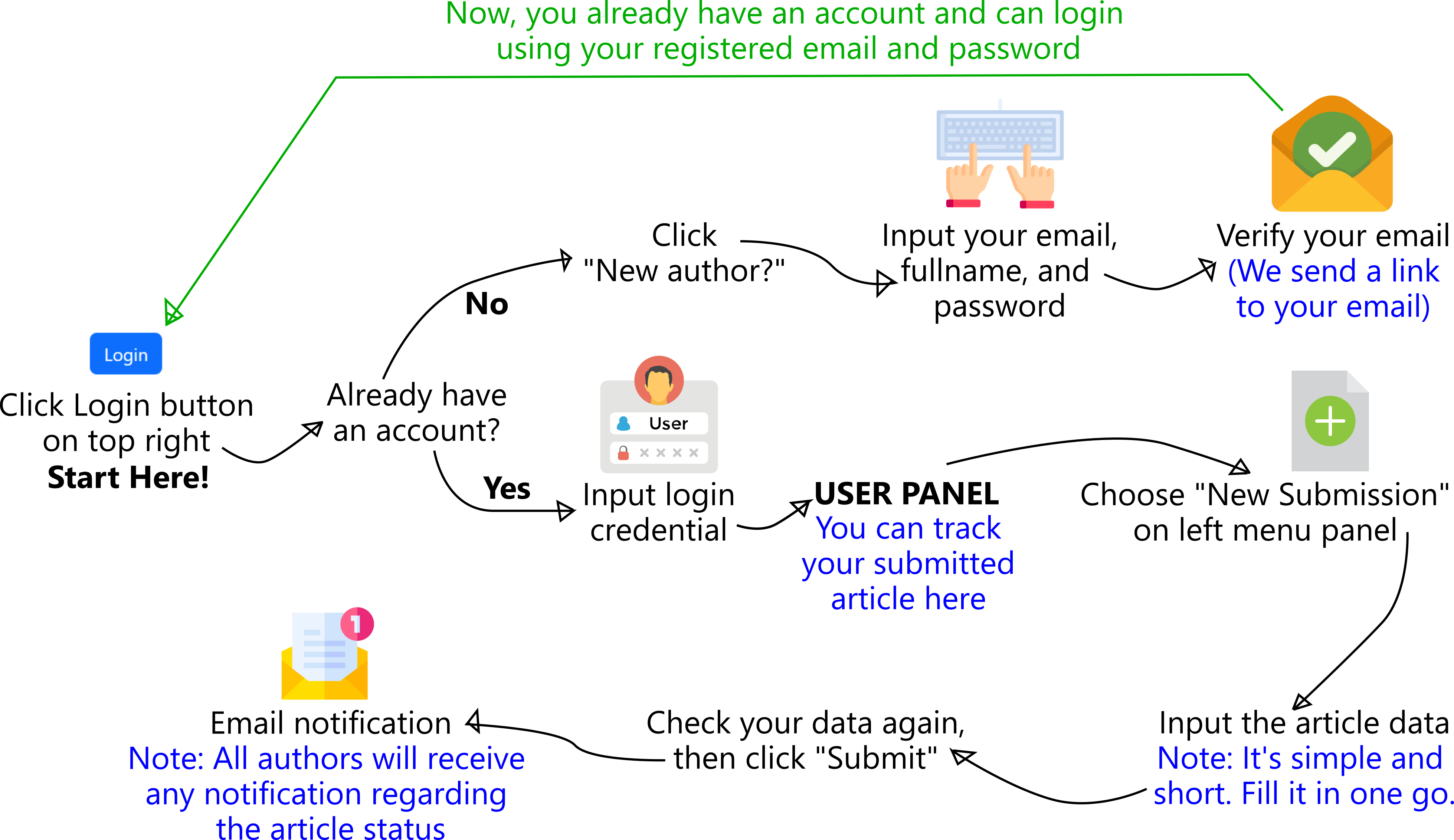
 ETFLIN
Notification
ETFLIN
Notification
Guideline for authors to format and submit their manuscript.
These guidelines outline the requirements for manuscript submission to ensure a smooth peer review and publication process. Please follow these instructions carefully to avoid delays.
We use a submission system that can be accessed by registering an account through the Login button (top right).
Note: We require the authors to submit the manuscript by themselves.
Co-authors can also track the manuscript's progress by logging in using the same email entered during submission.

We encourage the author to use our universal template (download). All instructions are within the template, and it is easy to follow. The template is applicable for all journals of ETFLIN.
Original Article must contain these sections:
Any structure is acceptable for other types of manuscripts as long as it contains: an Abstract, Introduction/Background, and Conclusion/Summary (a summary can be included within the discussion section). Also make sure that you use the heading styles to manage your sections.
Note:
If you use our template, then you can easily set up the font style. We use the Segoe UI font style with font size as follows:
The full name of the authors should be entered correctly including first name, middle name, and last name. It is mandatory to provide the email address of all the authors during the online submission process. If possible, the ORCID ID of the authors may also be provided.
The authors should provide their full affiliation in detail and correct order, in the online submission system. The authors should provide all the necessary information regarding their Department, Faculty/School, College/University, City, PIN code, State, and Country.
Example (author with one affiliation): Department of Pharmaceutical Sciences, Faculty of Pharmacy, Universitas Padjadjaran, Jatinangor 46353, Sumedang, Indonesia.
Example (author with multiple affiliations): Department of Pharmaceutical Sciences, Faculty of Pharmacy, Universitas Padjadjaran, Jatinangor 46353, Sumedang, Indonesia; Medical Informatics Laboratory, ETFLIN, Palu City 94225, Indonesia.
Please don't include titles, degrees, or statuses in the authorship information. While we hold the utmost respect for academic achievements, our goal is to promote equality in publishing, valuing the work of both young and senior researchers. These statuses could also change over time.
You can also input your ORCID ID (not the entire link, e.g., 0000-0000-0000-0000) in the authorship input during submission, and we will add your ORCID to the final version of the published PDF.
Note: Please use your institutional email. If you have multiple email, you can declare it after your affiliation. Use semicolon (;) as separator.
Provide 3-6 unique and diverse keywords. One keyword must not exceed three words, and using abbreviations in keywords should be avoided. Choose keywords that highlight the crucial aspects of your work, excluding those already mentioned in the article title or extensively covered in the abstract. Keywords play a significant role in enhancing the visibility of your work in search engines. Therefore, using unique and distinct keywords from the title and abstract allows for a broader and more specific search scope for your work.
The graphical abstract ought to present a smooth and coherent overview of the entire research process.

Although optional, our editor may find your graphical abstract appealing and choose it as the issue cover.
Please use dots as a decimal marker, not commas.
We only accept the Vancouver style with parentheses (1), not bracket [1].
[For Mendeley and Zotero] You can download Vancouver style tailored for ETFLIN Journals here: https://csl.mendeley.com/styles/687705971/etflin-vancouver
Authors are encouraged to use software such as Mendeley, Zotero, etc., to arrange the references. Mendeley and Zotero can be downloaded and installed. Once installed, they will appear on the 'References' tab on the Microsoft Word document.
You can read our citation policy for a better understanding.
To ensure that the study can be replicated, detailed information about the materials, software, and instruments must be provided, either in a separate section or in relevant places. The information that needs to be included is the grade/version/purity/type, brand, company, and country. Additionally, authors can attach a Certificate of Analysis or similar documents for new materials as supplemental data that will be published alongside the manuscript.
All abbreviations in the manuscript must be spelled out in full the first time they are used in the text. If not, a specific section should be provided to explain the full forms of all abbreviations.
The use of Grammarly is encouraged to minimize grammatical errors. Grammarly can be downloaded, installed, and added to the Microsoft Word document.
Please include funding information in your submission using the designated input field. Provide the full name of the funding agency and the grant number.
Do not include funding information in the manuscript itself.
In terms of planning the study design, data analysis, statistical analysis, software, executing work, writing, and editing, a significant contribution should be made by all contributing authors, such as the first author, co-authors, and corresponding authors. Authors are encouraged to get familiar with the Committee on Publication Ethics (COPE) guidelines.
The corresponding author will be responsible for communicating with the editors from the initial submission till publication. Depending on the requirement, there may be two corresponding authors. In the case of two corresponding authors, the asterisk '*' sign should accompany their names in the manuscript, and the initials of the authors should accompany their email addresses in the manuscript.
During the review process, the corresponding author may request that the authorship be changed, providing appropriate reasons for the request. It is not permitted to add or remove authors once a submission has been accepted.
If possible, authors are requested to submit a plagiarism report from commercial software (or from an accessible online server) as supplemental data. For all types of articles, the plagiarism percentage should be kept as low as possible (maximum upper limit 15% excluding references). Even if the plagiarism percentage remains below 15%, the authors may be further asked to reduce the plagiarism to increase the manuscript's authenticity.
Other details about our policies and guidelines can be accessed in these following links:
As a publisher, we create, store, and utilize cookies to enhance the features and services we provide. Several necessary cookies are implemented as part of the website's functionality.
_ga | etflin.com
The purpose of this cookie, set by Google Analytics, is to track the number of site visitors by remembering whether or not you have previously visited our website.
The following cookies are utilized to identify and authenticate users. By utilizing our service and registering an account within our system, you are consenting to the use of the following cookie. We do not share this data to any third party.
username | etflin.com
We employ this cookie to recognize users who have logged into the user system, ensuring that the data you manage is labeled with your username.
email | etflin.com
Email is utilized as our communication tool to send notifications, conduct initial registration verification, and account filtering.
name | etflin.com
We utilize your name to display on the website menu, indicating that you have successfully logged into the system.
token | etflin.com
We use a token to authenticate and identify your login session.
We Revolutionize Sciences, We Publish Sciences, We Are Scientist
ETFLIN